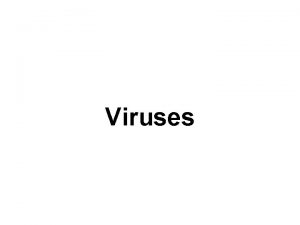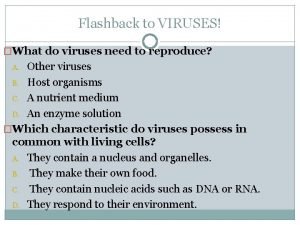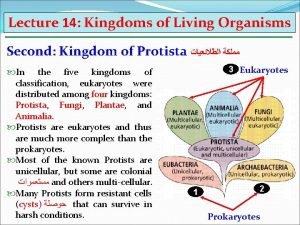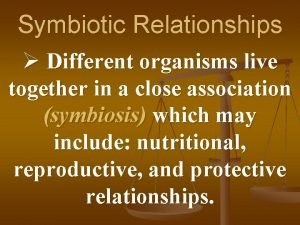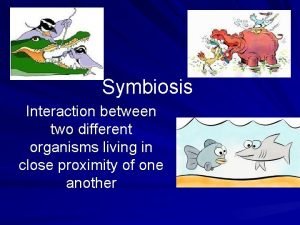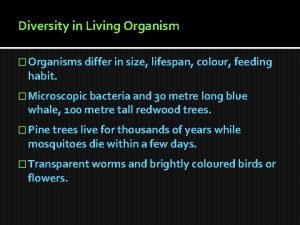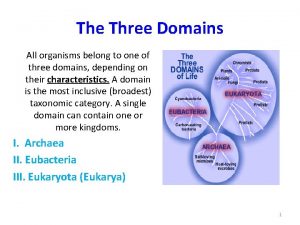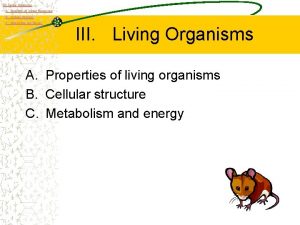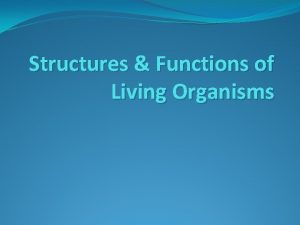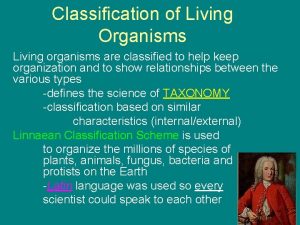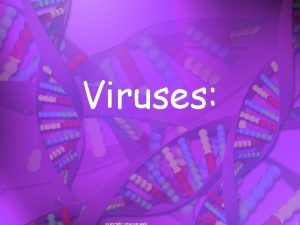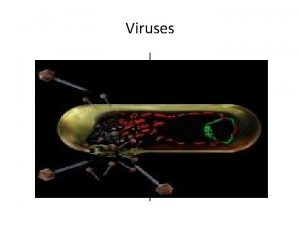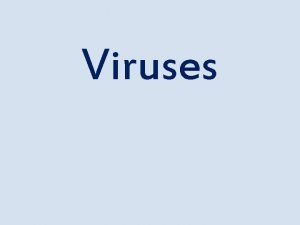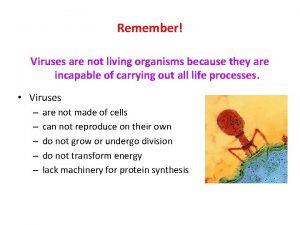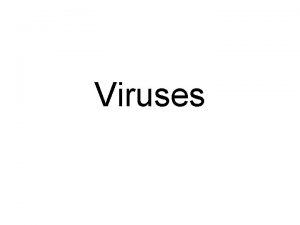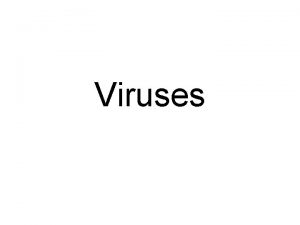Viruses Viruses are not living organisms Viruses do























- Slides: 23

Viruses

Viruses are not living organisms Viruses do not – Grow – Have homeostasis – Metabolize Viruses do – Infect cells and use the cell to make more viruses – Cause disease in many organisms

Parts of a Virion (a virus particle) Nucleic Acid – RNA or DNA Capsid – protein coat that surrounds the DNA or RNA in a virus Lipid Membrane – a membrane around the capsid in many kinds of viruses; helps the virus enter cells (“enveloped” viruses; without the membrane, the virus is “naked”) – Made of proteins, lipids, and glycoproteins

RNA or DNA? Viruses with RNA – Human immunodeficiency virus (HIV) – Influenza viruses – Rabies Viruses with DNA – Warts – Chickenpox – mononucleosis

Virus Shapes Helical Rodlike with capsid proteins winding around the core in a spiral Tobacco Mosaic Virus

Virus Shapes Polyhedral Has many sides Most polyhedral capsids have 20 sides and 12 corners

Virus Shapes Polyhedral capsid attached to a helical tail.

How do viruses replicate? 2 methods of replication: 1. Lytic Cycle – the virus enters the cell, replicates itself hundreds of times, and then bursts out of the cell, destroying it. 2. Lysogenic Cycle – the virus DNA integrates with the host DNA and the host’s cell helps create more virus DNA. An environmental change may cause the virus to enter the Lytic Cycle.

In the lytic cycle, the virus reproduces itself using the host cell's chemical machinery. The red spiral lines in the drawing indicate the virus's genetic material. The orange portion is the outer shell that protects it.

In the lysogenic cycle, the virus reproduces by first injecting its genetic material, indicated by the red line, into the host cell's genetic instructions.

Viruses Enter Living Cells Viruses enter bacterial cells by punching a hole in the cells wall and injecting its DNA

Viruses Enter Living Cells Viruses enter plant cells through tiny rips in the cell wall. Viruses enter animal cells by endocytosis.

Mutating viruses Viruses can mutate when they copy the genetic material – Copy something wrong – Mistake proves useful – More powerful virus (more infectious) Viruses don’t mutate often, except… – Influenza – HIV

Viruses are host cell specific. Most viruses are restricted to certain kinds of cells (those that infect plants cannot infect animal cells). Why? Scientists think that viruses originated from escaped genetic material from host cells.

Viruses can be beneficial… Bacteriophages – attack & destroy bacteria Baculovirus – ebola-like virus that attacks insects – Could use for pest control in crops • Cabbage loopers eat cabbage crops • Virus can kill pests in days – (it’s really gross) … and then there are those that are not so good….

Also important… Any agent (not just viruses) that causes disease is a pathogen. When a virus inserts its genetic material into a host’s DNA, it is called a provirus. Some viruses replicate very slowly and only cause damage when the conditions are “right”. (cold sores)

Human Immunodeficiency Virus (HIV) Acquired Immuno Deficiency Syndrome (AIDS)

Basic Structure • Viral envelope – lipid bilayer; glycoproteins protrude from surface – Glycoproteins enable virus to recognize surface proteins of special immune cells and to enter the cell (like a key to the cell’s door) • 2 strands RNA – only 9 genes; 3 are found in many viruses (structural proteins) • Reverse Transcriptase – turns RNA into DNA (this makes HIV a retrovirus); DNA instructs cell to make more viruses


HIV Making Factories • Virus enters cell through endocytosis • Virus replicates RNA to DNA with reverse transcriptase

• DNA enters nucleus & binds with host DNA • m. RNA is created (carries instructions for making new viral proteins) and leaves nucleus • Uses host cell’s enzymes to make new viruses • New virions exit cell through exocytosis to infect other cells (notice cell isn’t destroyed)

How Is HIV Spread? • • • Sexual contact Sharing contaminated needles Blood transfusions Breast feeding (mother to baby) Mother to baby during pregnancy or birth

Think about it… • In the US, there is better than a 1/1000 chance of contracting HIV during unprotected sex • A person can be contagious for more than 10 years before any sign of the disease is apparent • HIV becomes AIDS when the number of immune cells drops below a predetermined number • No one dies from HIV or AIDS; people die from secondary infections (ranging from the common cold to cancer) • More than 3 million people (size of Chicago) die each year • There approx. 14, 000 new cases of HIV worldwide every day
 /watch?v=dckvspcd8gs
/watch?v=dckvspcd8gs Unlike lytic viruses lysogenic viruses do not
Unlike lytic viruses lysogenic viruses do not Antigentest åre
Antigentest åre Venn diagram of living and non living things
Venn diagram of living and non living things How do viruses differ from living things
How do viruses differ from living things Competitive interaction
Competitive interaction Unicellular and multicellular organisms
Unicellular and multicellular organisms Lysogenic viruses do not
Lysogenic viruses do not Macronucleus
Macronucleus Living organisms
Living organisms 5 kingdoms of living things
5 kingdoms of living things Two different organisms living together
Two different organisms living together Two different organisms living together
Two different organisms living together Mynah and buffalo interaction
Mynah and buffalo interaction Remains imprints or traces of once-living organisms
Remains imprints or traces of once-living organisms Diffrent types of fossils
Diffrent types of fossils Three living organisms
Three living organisms Guinea worm
Guinea worm 6 kindoms
6 kindoms Planaria, liverfluke, tapeworm, ascaris *
Planaria, liverfluke, tapeworm, ascaris * What is the smallest living unit in the body
What is the smallest living unit in the body Three domains of life
Three domains of life Different types of living organisms
Different types of living organisms Small living organisms
Small living organisms




